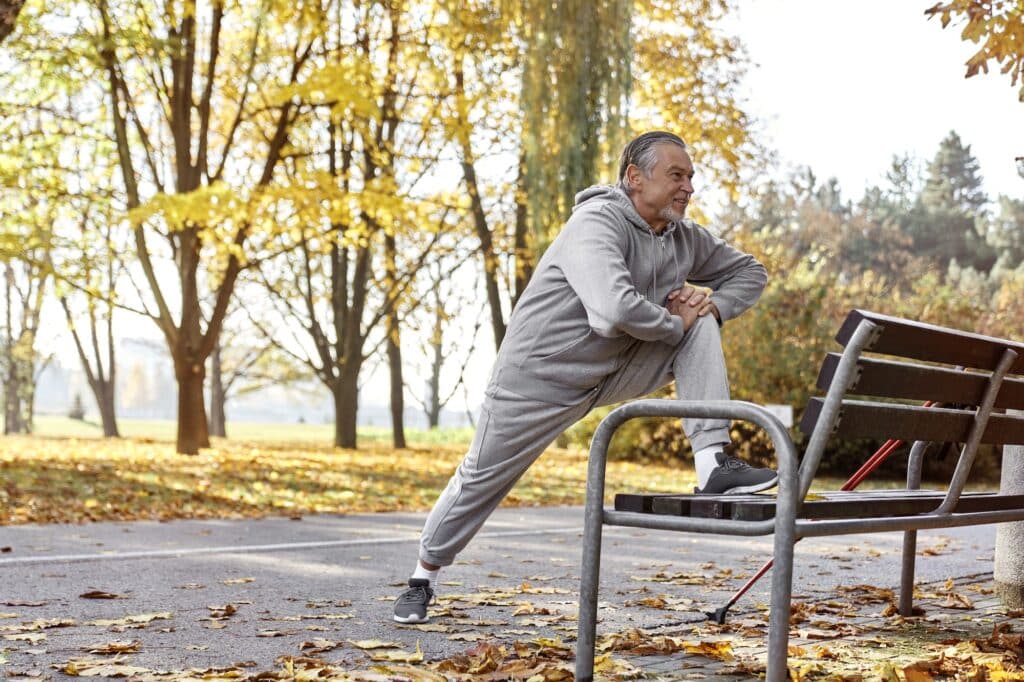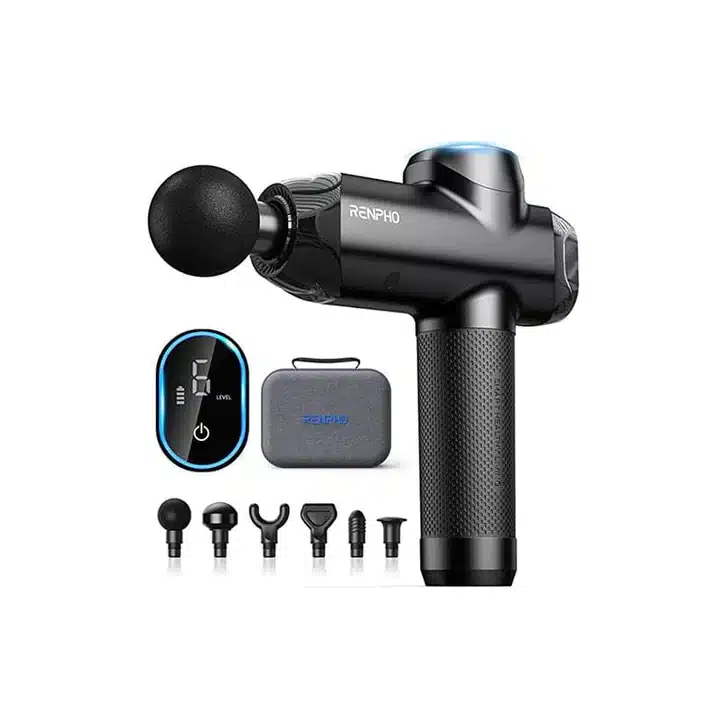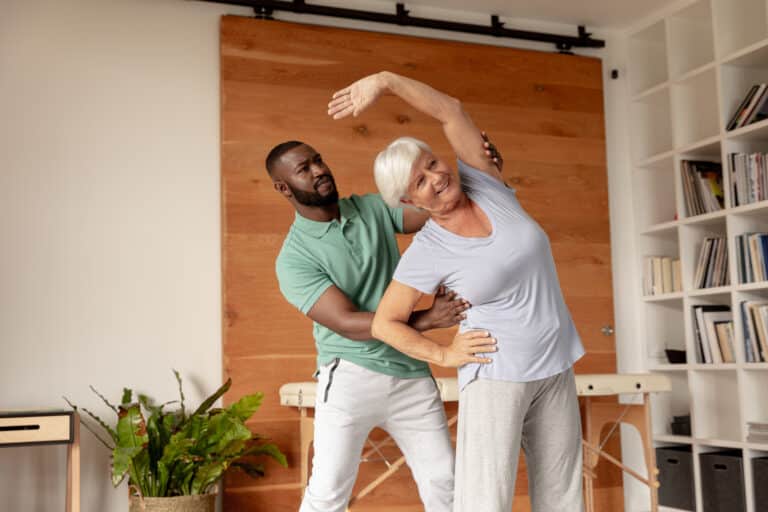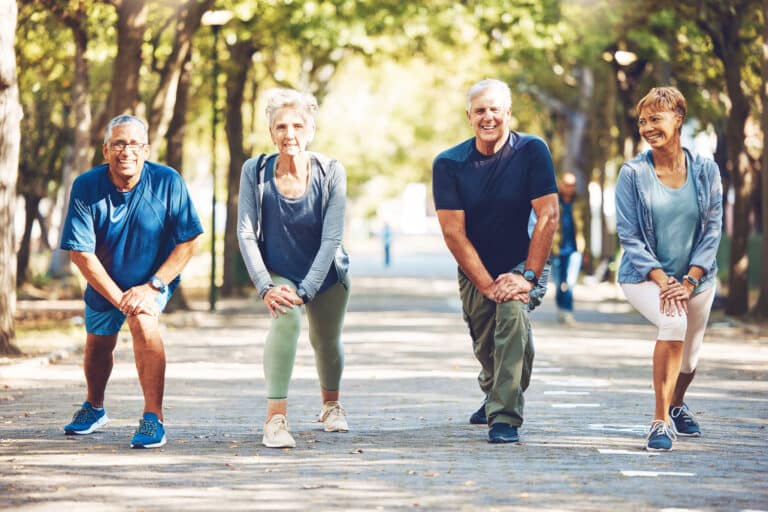Mobility vs. stretching…It’s a common misconception that mobility and stretching are the same, and the terms are often used interchangeably. What one person calls mobility training, another might call active stretching.
Let’s outline the difference between mobility and stretching, why they’re essential, and how to use each to reach your fitness goals at any age.
What is Mobility?
Mobility refers to a combination of flexibility and strength.
Being “mobile” involves getting yourself into a specific position (or range of motion) with the ability to function in that position. For example, the ability to lower into a squat, grab something off the ground, and lift it back up to a standing position would be considered good mobility.
An example of poor mobility might be someone who can get into a squat position but cannot hold the position or lift any weight from the squat without problems or pain.
In this case, lack of stability signals the brain to stop the movement before an injury occurs; the body understands it cannot function in that range of motion.
Mobility allows for functional movement, not just flexible muscles.
Why Mobility Is Important as We Get Older
Studies have shown that age-related mobility loss in everyday movements can lead to a decline in overall health and a lower quality of life. (1)
Research also shows that maintaining mobility has enormous benefits. Mobility exercises can lead to:
- Better joint health
- Lower injury risk
- Better posture
- Increased ease of movement
- Greater movement capacity
- Longer physical independence
Exercises To Improve Your Mobility
Incorporating a few mobility exercises into your workouts or daily activity can improve how your joints feel when you move. Here are a few simple exercises to get you started.
Hip Circles
This mobility exercise targets your hip joints, making squatting or standing up from a chair much more manageable.
- Start by lying face up on the floor with your legs extended.
- Bend one leg, so your knee points to the ceiling.
- Draw circles with your knee several times in one direction, then switch. Repeat with the other leg.
Lying Arm Circles
You can perform arm circles standing up, but doing this exercise on your back can lower the risk of injury if this is a challenging range of motion.
- Start by lying on your back, with arms at your sides, your knees bent, and your head resting on a towel.
- Lift your arm about three inches off the ground and make a large, slow sweep of both arms until you reach overhead.
- Slowly return to the start position. Do not move past that point if you feel pain in any part of this exercise.
Lying Overhead Shoulder Flexion
This movement can help to improve the range of motion in the shoulders. You’ll need a light dowel, broomstick, or PVC pipe to perform these.
- Begin by lying on your back with your knees bent while holding a dowel in both hands, with your hands slightly wider than your shoulder’s width.
- Slowly raise both straight arms overhead as if trying to touch the backs of your hands to the floor.
- Pause at the end of the comfortable range of motion and return to the starting position.
Knee-to-Chest
This movement can help to improve range of motion for the hip joints
- Begin by lying on your back, and bring one knee to your chest, clasping your hands across your knee
- Squeeze your knee toward your shoulder until you feel a stretch in your hip and gluteal muscles
- Return to the start position and switch legs.
Child’s Pose
This is a yoga pose that allows you to gently stretch your hips, knees and low back .
- Starting on all fours, rock your hips toward your heels.
- Once you begin to feel stretch or resistance from your body, pause and take several deep breaths.
- Return to the start and repeat as needed.
Cat and Cow
This simple spinal movement allows you to move your spine in two fundamental dimensions safely.
- Begin on all fours, and with a deep inhale lift your chest and drop your belly; this is “cow” pose.
- As you exhale, round your back and tuck your chin as if you are trying to look at your knees.
- Following your breath, repeat each position for 10-12 repetitions.
What is Stretching?
Stretching is a passive practice that allows you to achieve greater ranges of motion (ROM) by slowly lengthening muscles and tendons.
A flexed muscle must also be able to lengthen to prevent injury. Regular stretching practice can ensure that your tissues are strong and flexible.
There are two primary forms of stretching:
- Static stretching involves holding a pose.
- Dynamic stretching uses active movements to improve flexibility.
Both options will increase your stretch tolerance, which lessens the stretch reflex. You can think of the stretch reflex as your body’s way of preventing injury from over-stretching. (5)
Daily stretching can lengthen the muscle, signaling to your central nervous system that the movement is safe. As a result, the stretch reflex lessens, and your range of motion increases, so eventually, touching your toes won’t feel quite as challenging.
The Benefits of Stretching as We Get Older
Stretching encourages the flexibility necessary for an improved range of motion and mobility. So, while mobility exercises are great before a workout, stretching afterward is also a good idea.
Recent research shows that regular stretching may help older adults (6, 7, 8):
- Reduce lower back pain,
- Reduce arthritis pain,
- Increase blood circulation,
- Increase energy levels,
- And improve balance, thereby preventing falls.
Can A Massage Gun Help With Mobility?
A massage gun is a device that delivers rapid pulses of pressure to the muscles, which can help with mobility in several ways. It can reduce muscle tightness and stiffness, which can limit the range of motion of the joints. It can also break up scar tissue and adhesions, which can impair muscle function and mobility.
We recommend the RENPHO R3 Massage Gun to our patients. It is light, and the ergonomic handle makes it easier than other models to position in just the right spot. Currently priced at about $100, it is also the most affordable massage gun without trading off any quality.
Our recommendations are the same items we trust and prescribe to patients. When you buy through links like this on our site, we may earn an affiliate commission to support new content.
Dynamic Stretches to Prevent Strain Before Exercise
Dynamic stretching involves movements intended to bring blood flow to the tissues; you can consider these “moving” stretches.
An easy way to incorporate dynamic stretching at the beginning of your warmup is to do exercises that bring attention and movement to the areas you are about to use without holding the stretch.
Here are some examples of stretches that might be helpful before a workout.
Dynamic Hamstring Stretch (pre-workout)
This stretch will help to signal to the muscles of the legs to prepare for walking, jogging, running, hiking, or biking.
- Extend one foot slightly in front of the other, with the heel on the ground and the extended leg mostly straight.
- With a straight spine, lean forward at the waist and gently “bounce” ten to fifteen times as you feel a light stretch at the back of the calf, thigh, and hip.
- Repeat on the opposite leg.
Wide-Legged Straddle Stretch
This stretch targets the groin and inner thighs:
- With a wide stance, bend your right leg while keeping your left leg straight, and shift your body weight to the right.
- Repeat to the left.
- Alternate from side to side ten to twenty times.
Static Stretching to Lengthen Muscles After Exercise
Adding a stretching routine to the end of your workout is the optimal way to get the most benefit from deeper stretches.
Unlike dynamic stretches, static stretching requires holding a position for thirty or more seconds, which helps your muscle lengthen after your workout. This is much easier when your muscles are warm.
Here are some static stretches to cool down after exercise.
Static Standing Hamstring Stretch
- Place your right foot on a chair or other surface at or below knee height. Holding onto a chair or surface for balance support may be helpful.
- With your legs mostly straight, gently turn your torso to the right.
- Hold for thirty seconds and repeat on the other leg.
Hip Flexor Stretch
This is a stretch sequence for the hip flexors– the muscles in the front of your hip where you bend to sit in a chair.
- Start in a kneeling lunge position with one knee on the ground and the other foot flat on the floor in front of you. The knee on the ground is the leg you will be stretching.
- Gradually shift your torso forward over your front leg until you feel a stretch around the front side of your back leg. Be sure not to arch your back by keeping your abdominal core muscles engaged.
- If you cannot kneel, try this same stretch while standing in a lunge position with your back leg straight. Hold for 20-30 seconds. Complete 2-3 repetitions on each side.
Remember to breathe deeply when static stretching to relax the muscles and allow them to lengthen. While you may feel tension, you shouldn’t feel pain.
Key Takeaways
- Mobility and stretching are distinct: Mobility combines flexibility and strength for functional movement while stretching passively lengthens muscles and tendons.
- Mobility is essential for functional movement, allowing actions like squatting and lifting, and becomes increasingly important with age to maintain health and independence.
- Incorporating mobility exercises into daily routines can improve joint health, reduce injury risk, and enhance posture.
- Specific mobility exercises include hip circles, lying arm circles, and lying overhead shoulder flexion.
- Stretching, both static and dynamic, helps achieve greater ranges of motion and reduces pain and improves balance in older adults.
- A massage gun, like the RENPHO R3, can aid in improving mobility by reducing muscle tightness and breaking up scar tissue.
- Dynamic stretches are recommended before workouts to warm muscles, while static stretches are beneficial after exercises to lengthen muscles.
References:
- Luigi Ferrucci, Rachel Cooper, Michelle Shardell, Eleanor M. Simonsick, Jennifer A. Schrack, Diana Kuh, Age-Related Change in Mobility: Perspectives From Life Course Epidemiology and Geroscience, The Journals of Gerontology: Series A, Volume 71, Issue 9, September 2016, Pages 1184–1194, https://doi.org/10.1093/gerona/glw043
- Chyu MC, von Bergen V, Brismée JM, Zhang Y, Yeh JK, Shen CL. Complementary and alternative exercises for management of osteoarthritis. Arthritis. 2011;2011:364319. doi: 10.1155/2011/364319. Epub 2011 Jul 25. PMID: 22046516; PMCID: PMC3200004.
- Storm JM, Wolman R, Bakker EWP, Wyon MA. The Relationship Between Range of Motion and Injuries in Adolescent Dancers and Sportspersons: A Systematic Review. Front Psychol. 2018 Mar 22;9:287. doi: 10.3389/fpsyg.2018.00287. PMID: 29623052; PMCID: PMC5874564.
- Reiman MP, Matheson JW. Restricted hip mobility: clinical suggestions for self-mobilization and muscle re-education. Int J Sports Phys Ther. 2013 Oct;8(5):729-40. PMID: 24175151; PMCID: PMC3811738.
- Bhattacharyya KB. The stretch reflex and the contributions of C David Marsden. Ann Indian Acad Neurol. 2017 Jan-Mar;20(1):1-4. doi: 10.4103/0972-2327.199906. PMID: 28298835; PMCID: PMC5341261.
- National Institute of Health https://www.nih.gov/news-events/nih-research-matters/yoga-or-stretching-eases-low-back-pain
- Wexner Medical Center; Ohio State University https://wexnermedical.osu.edu/blog/benefits-of-stretching
- Nelson AG, Kokkonen J, Arnall DA, Li L. Acute stretching increases postural stability in non-balance trained individuals. J Strength Cond Res. 2012 Nov;26(11):3095-100. doi: 10.1519/JSC.0b013e3182430185. PMID: 22130394.






